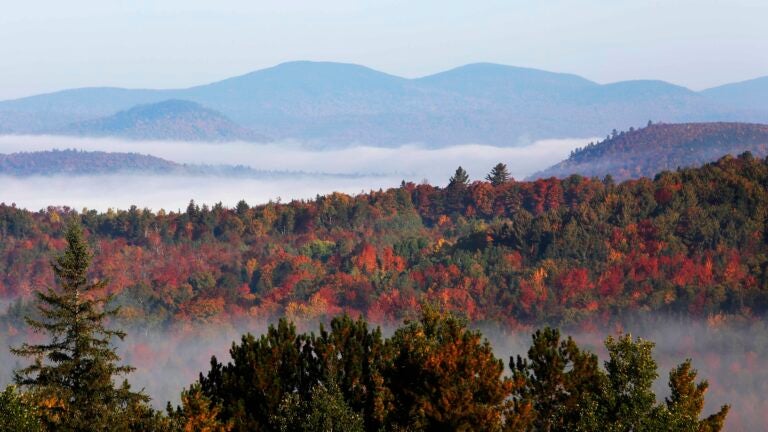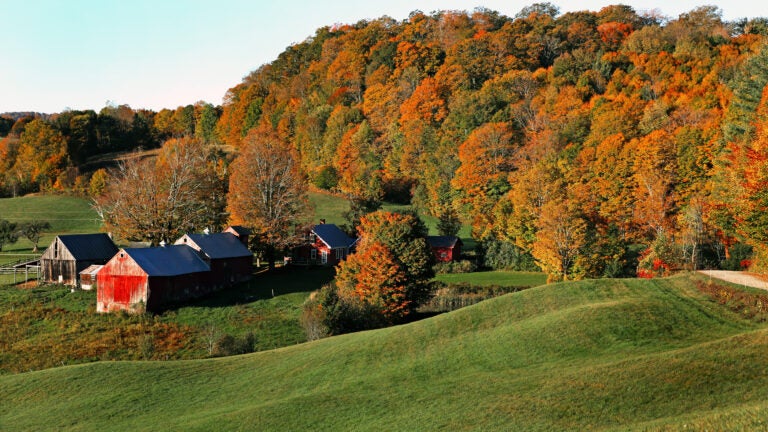Your ultimate guide to New England fall foliage
Everything you need to know for the perfect leaf-peeping experience.

Related Links
Fall is just around the corner, which means that before you know it, the local landscape will see an explosion of color. New England is renowned for its brilliantly hued leaves, attracting leaf peepers from all over the U.S. who seek the autumnal tapestry of New Hampshire, Vermont, Maine, and sometimes even the lower half of New England.
While 2018’s foliage was a mixed bag, with warmer-than-normal temperatures leading to a “splotchy” leaf-peeping season, foliage experts believe the signs point toward a return to normalcy in 2019 — with “normalcy” in this case meaning the same beautiful scenery New Englanders have come to expect year after year.
To help you maximize your experience, we talked to Jim Salge, a former meteorologist at Mount Washington turned high school physics teacher who shares his leaf-peeping insights on New England Today and his eye-popping foliage photographs on his website.
What makes for a great fall foliage season?
The weather from earlier in the year plays a role in how brilliant the foliage will be that fall. Salge said that the conditions from spring 2019 should lead to some fantastic colors this season.“The best foliage usually comes out when trees are healthy, after a normal spring and summer with adequate rainfall,” Salge said. “We had a late spring across all of New England, and that really led the trees to miss a lot of the risk factors that can be associated with early, wet springs. We didn’t have a lot of fungus, and we didn’t have a lot of bugs this year, so the trees are healthy.”More important, however, are the weather conditions during fall itself. Ideal foliage will come from warm, sunny days and crisp, cold nights: Cooler temperatures make the leaves reveal the orange and yellow shades they’re hiding underneath, while bright days bring out their brilliant red colors, which act as a sort of sunblock. “As the days start to shorten, we really want warm, sunny days and crisp, cold nights to kind of kickstart the process,” Salge said. “Rainy fall seasons tend to have more muted colors, and bright, typically beautiful fall weather that New England is known for bring out the best fall colors.”While all signs point to a solid fall canvas, there’s still a chance that certain factors could lead to less-than-stellar leaf-peeping. In 2018, for example, Salge said that the weather simply never got cold enough, which is always a possibility. Rainy fall seasons can also negatively impact the leaves, leading to more muted colors. But Salge feels “fairly optimistic” about this year’s foliage.“I think we’re going to have a nice season,” Salge said. “We just need cold nights, and Vermont had a frost already this year, so the Northern part of Vermont is 10 to 20 percent turned already. New England fall rarely disappoints.”

Massachusetts fall foliage.
What sort of trees should you seek out?
You can spot gorgeous fall colors in many plants, even spruces and shrubs. However, the main attraction in New England is the majestic maple, found across the region’s forests and particularly in Maine and northern New Hampshire.
“The maples are really the prime trees that create the great colors New England is known for,” Salge said. “Red maples are turning already in the swamps. Sugar maples make up a lot of the Northern Forest.”
Though the Boston area can offer excellent colors, Salge said that oak trees are more commonly found here than maples, and oaks aren’t quite the color superstars that maples are.
“Oaks tend to be a more muted, rusty color,” Salge said, “while maples tend to be really, really vibrant.”

Sugar Hill, New Hampshire, with Franconia Notch as a backdrop.
When does fall foliage typically “peak” in the Greater Boston area?
As Boston.com’s own meteorologist/horticulture enthusiast Dave Epstein has noted in the past, the idea of “peak” foliage can vary from person to person, depending on whether you prefer the brilliant reds or the soft yellows of the leaves. Nevertheless, Salge pinpointed some opportunities for admiring the Boston area’s trees.“Blue Hills [Reservation] and the interior area of Boston usually peak sometime from Columbus Day through mid-October,” Salge said. “Boston Common is a beautiful place to see foliage, as is a trip along the Charles, but that usually isn’t [at peak foliage] until the last week in October, or even early November.”Salge said that proximity to the coast has a big impact on when a tree’s leaves turn. Trees located a bit more inland turn closer to Columbus Day. Those in Boston or close to the coastline turn nearer to the end of the month.

Runners pass the pond and gazebo of Larz Anderson Park in Brookline.
Where are some of the best leaf-peeping routes in New England?
If you don’t want to wait until late October for the leaves in Boston to hit their stride, Salge recommended these three weekend drives.Kancamagus Highway, New HampshireThe Kancamagus is a 32-mile stretch of Route 112 that runs through the White Mountains from Lincoln to Conway, and is renowned for its foliage. Known by locals as simply “the Kanc,” the route is now designated as an American Scenic Byway, due in large part to its reputation as one of the country’s top leaf-peeping spots.The Mohawk Trail, MassachusettsCambridge commuters may know Route 2 as a source of endless frustration and gridlock. But out in central and western Massachusetts, the highway becomes the Mohawk Trail, a 60-mile path through the Berkshires from Orange to Williamstown. If you want to make this drive for foliage-viewing purposes, Salge suggests Columbus Day weekend.Acadia Park, MaineWith its location on the Maine coastline, Acadia gives visitors the added bonus of seeing both incredible leaves and breathtaking shorelines. Acadia’s trees traditionally turn a bit later than the northwest parts of the state, but they’ll likely be on full display by early-to-mid October.






